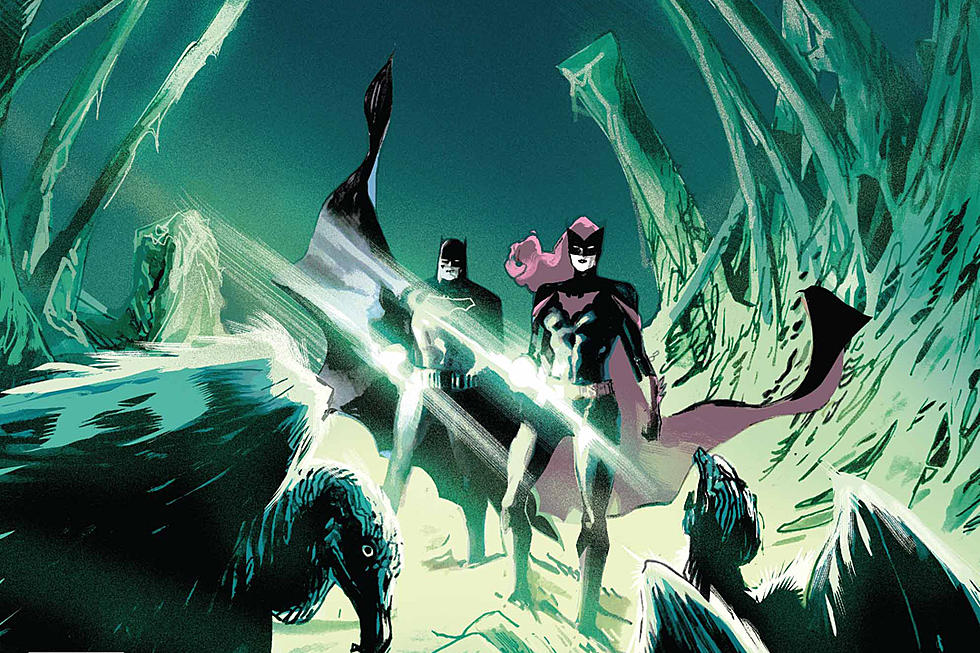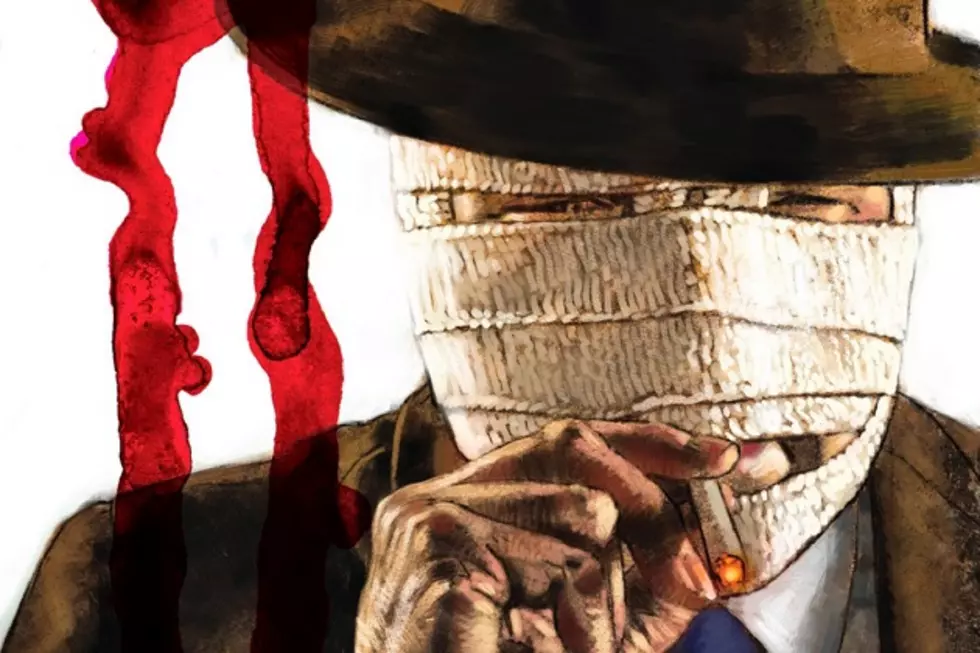
Ed Brubaker Talks Research, Collaboration, And The Cold War In ‘Velvet’ #1
In stores next month is Velvet #1, the newest spy tale from Ed Brubaker and Steve Epting, the team that spent years on arguably the most celebrated Captain America run in the character's history. Much of that run was driven by spy/espionage sensibilities, and the duo is bringing that aspect of their work to Velvet, the story of a veteran agent named Velvet Templeton who returns to the field to clear her name after she's framed for the murder of the world's top secret agent.
The series is a significant moment in the careers of both creators. For Brubaker, this was the first book announced after he left Marvel to focus on his own projects, and for Epting, Velvet is the veteran artist's first creator owned work.
With the first issue due out next month, and final orders due on Monday, ComicsAlliance joined a conference call with Brubaker in which he discussed, among other things, the research he did for the series, how cell phones have ruined suspense stories, the British spy who tried to seduce one of FDR's best friends, and how all of that influenced Velvet. You can check out some of the highlights from the call, plus preview art from the first issue as well as the cover to issue #2, below.
On what Velvet is and the origins of the series:
"Velvet is my attempt to do a more straight version of the sort of 'super spy' comic book. I wanted to find a way to kind of bring a sort of more realistic 'Tinker Taylor Soldier Spy' element to that kind of story, that sort of over the top spy action thriller. I felt like that was a good way for me and Steve Epting to take the things that we did on Captain America that people really liked and bring it to something that wasn't super heroes but still had enough of the same kind of elements that it would appeal to the same fans.
"I came up with this when I had a binge week of just watching old spy movies seven or eight years ago. I had been reading a lot of non-fiction about the Cambridge spy ring from the '50s and '60s that inspired things like Tinker Taylor Soldier Spy and a lot of the Smiley books. And I just kind of had this revelation that all the women characters in those stories, generally, were really lame and weak. There's the Moneypenny archetype in spy fiction and detective fiction. Sam Spade's secretary is in love with him, Mike Hammer's secretary is in love with him. And I just thought 'but what if that Girl Friday archetype was more like Modesty Blaise? What if she had a secret history and what if she was actually the most interesting person in that world?'"
On how Steve Epting became the artist on the series:
"After we did the 'Death of Captain America' story we're at a convention sitting at a bar, and I told him about the story and he immediately said 'I have to draw that!' That was about five years ago, I think, so I've kind of been waiting for Steve to be off his Marvel contract and done with all his other commitments. And I kept working on it in my notebook and fleshing out the whole world, and what started as kind of a twist on spy archetypes has really turned into this epic story."
On writing stories in the Cold War era:
"I think there are a lot of reasons to do stories in that era. Number one, no one has cell phones. Cell phones have ruined the movies in a way, because there's no tension anymore. Anytime anything is about to happen, everyone in the theater is thinking 'Why don't you just pick up your phone and call the cops?' The ability for people to be constantly gotten in touch with and tracked makes keeping an espionage story interesting, to me, a lot more difficult and a lot lamer, in a way. I like the idea of a spy being lost in the city and trying to get out, as opposed to just touching a thing on her ear and suddenly they're teleporting her.
"With the Cold War, there was a very clear idea of who are the good guys and who are the bad guys, and there's a murky gray area to explore in there about the way various intelligence agencies acted in that era, and it's just more interesting to me. These days the spy stuff is corporations spying on government, or government spying on corporations, or corporations spying on each other. Who are you going to root for, in that case? Are you rooting for Disney to beat Warner Bros.? That honestly wasn't meant to be a comic book references [Laughs]."
On Choosing a female lead for Velvet:
"The idea kind of came from an old episode of The Sandbaggers. When Greg Rucka first started doing Queen and Country he forced me to watch all of The Sandbaggers, and there was an episode where the main guy who runs MI:6 has to get a new secretary. And the whole point of the episode was to show that the person who becomes the right hand person of the man who runs this agency has to be one of the most qualified people, and they're actually as knowledgeable about what the agency is doing as the director is, and is actually sometimes more knowledgeable because sometimes they have to weed out all the stuff that the director doesn't need to see or know. And I thought 'What if you took that character and put her in a situation where she was framed for the murder of a James Bond type, and had to go on the run, and it turned out she had this much more interesting back story?' So the whole time I was thinking of this idea, it was always going to be a woman.
"And Black Widow was always more interesting to write than any other character she was in a book with [Laughs]. So that helps too."
On the type of research he did for the book:
"I spent most of my time, whenever I'd go back to this project, reading a lot of non-fiction about the entire field and trying to get as much history of the Cold War as I could. You don't actually find stuff about women spies other than Russian women spies, or the odd thing about British women spies. There was a story I read about a woman who, before America was in World War II, there was a British spy who was sent over to basically seduce one of FDR's best friends to try to get America to join the war, which I thought was really interesting. It's one of the few times that one of the allies will admit that they used a honeypot."
On the comfort level he has working with Steve Epting:
"It's interesting because the last thing Steve and I did together was our final issue of Captain America. I hadn't worked with Steve much for the last 3 or 4 years, so when we got back together to work on this, each of us was determined to come up with some kind of new style to set it apart from what we'd done before, and both of us really struggled for the first five or six pages figuring out what the hell we were doing, so eventually I said 'Okay, let's just do this the way we normally work.'
"When I got to the first big action scene in the issue, I could see it being choreographed in my head as I was describing it, and I knew exactly how to write all the right things Steve would need to make it sing, and I could feel a sense of relief when I sent something and I knew 100% what I was going to get back. I've worked with a lot of great guys, but with Sean [Phillips] I always know what I'm going to get, with Steve I always know what I'm going to get. Sometimes they both do something completely different that blows me away. But really the collaborator is the most important part, and I think that's one of the things that you're seeing now with this sort of wave of people leaving the bigger publishers and heading over to Image or other places where they can do their own stuff. When they can bring their collaborators with them, it makes it a lot easier. I don't think I could have done this book without Steve."
On the plot of Velvet:
"One of the things I haven't really talked about is that it's a murder mystery, and to solve the murder mystery Velvet basically has to retrace the steps of one of the word's greatest super spies, so a lot of the story of the book is her sort of going through the aftermath of these places where there's been Mission Impossible and James Bond kind of scenarios, where they're blowing up the factory on the island where everybody has a job. Some of it is actually about blow back, and the consequences of these things. You never see what happens to the Bond girl if she survives after she's been seduced by James Bond and gives up all of her country's secrets, and then he goes off and gets a medal on the space shuttle or whatever, but you never see that girl again. So part of it was 'What happens to her? Is she in prison, on death row, or is she just immediately executed?' I wanted to sort of look at that, because I think the aftermath of stuff is really interesting, and that helps me bring that sort of realistic tone to it. Doing a spy story that's also a murder mystery is a lot more fun."
On the extras and essays that will be in the single issues:
"I have a surprise for the first issue that I don't want to spoil, but there's going to be lots of stuff like that. I feel like that's really helped Sean and I build an audience. For Fatale we sell the same amount of copies every month now, and I think that's partially because our readership feels like they're getting a package that's worth their money, so I want to make sure that's how it feels every time one of my books comes out. Whether it's Fatale or Velvet, you want to have some extra special things. I feel like people still don't understand how Image works. People think Image Comics is paying us page rates and is the one taking all the risks on this thing. And while creator owned books are doing pretty well right now so it's not a huge amount of risk, selling single issues is what allows us to keep being able to do these books. The trades, the media rights, and all that stuff, that's all the long game, and you wouldn't be able to afford to do the book if we didn't have people buying it every time. To me it seems like a no brainer to put extra content that's only available in the single issues. It took a few years before people stopped giving me flack for not reprinting all those articles in the back of the trade paperbacks.
"I want all the single issues to feel like magazines that you can go back to."
Velvet #1 goes on sale October 23 at your local comic shop and digitally via Comixology and Image Comics' website.
More From ComicsAlliance


![‘Batwoman’ #1 Delivers A Globetrotting Gay Adventure [Review]](http://townsquare.media/site/622/files/2017/03/BW_featured.jpg?w=980&q=75)



![Marguerite Bennett And Steve Epting Relaunch ‘Batwoman’ In 2017 [NYCC 2016]](http://townsquare.media/site/622/files/2016/10/batwoman_featured.jpg?w=980&q=75)
![Brilliant Art, Tremendous Stories and Daring Creators: The 2016 Eisner Award Winners [SDCC 2016]](http://townsquare.media/site/622/files/2016/07/eisner2016.jpg?w=980&q=75)

